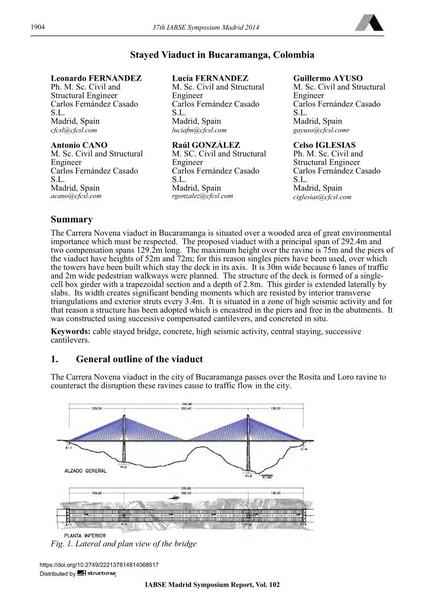Stayed Viaduct in Bucaramanga, Colombia

|
|
|||||||||||
Bibliografische Angaben
| Autor(en): |
Leonardo Fernández
Lucía Fernández Guillermo Ayuso Antonio Cano Raúl González Celso Iglesias |
||||
|---|---|---|---|---|---|
| Medium: | Tagungsbeitrag | ||||
| Sprache(n): | Englisch | ||||
| Tagung: | IABSE Symposium: Engineering for Progress, Nature and People, Madrid, Spain, 3-5 September 2014 | ||||
| Veröffentlicht in: | IABSE Symposium Madrid 2014 | ||||
|
|||||
| Seite(n): | 1904-1910 | ||||
| Anzahl der Seiten (im PDF): | 7 | ||||
| Jahr: | 2014 | ||||
| DOI: | 10.2749/222137814814068517 | ||||
| Abstrakt: |
The Carrera Novena viaduct in Bucaramanga is situated over a wooded area of great environmental importance which must be respected. The proposed viaduct with a principal span of 292.4m and two compensation spans 129.2m long. The maximum height over the ravine is 75m and the piers of the viaduct have heights of 52m and 72m; for this reason singles piers have been used, over which the towers have been built which stay the deck in its axis. It is 30m wide because 6 lanes of traffic and 2m wide pedestrian walkways were planned. The structure of the deck is formed of a single- cell box girder with a trapezoidal section and a depth of 2.8m. This girder is extended laterally by slabs. Its width creates significant bending moments which are resisted by interior transverse triangulations and exterior struts every 3.4m. It is situated in a zone of high seismic activity and for that reason a structure has been adopted which is encastred in the piers and free in the abutments. It was constructed using successive compensated cantilevers, and concreted in situ. |
||||
| Stichwörter: |
Beton
|
||||
